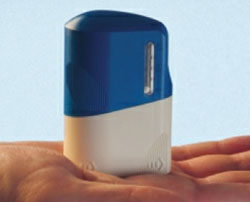When the Akela stopped development on the Taifun inhaler, then-President and CEO Greg McKee asserted that the discontinuation would allow the company “to fully deploy its management and capital resources on the profitable PharmaForm subsidiary.”

The Taifun inhaler
In December of 2012, however, Akela voluntarily delisted from the Toronto Stock Exchange, stating that “doubt remains regarding the Corporation’s ability to continue as a going concern.” Soon after, Akela signed the lease with B.I.G., and two months later, Akela announced that it was in default on the lease and that B.I.G. had foreclosed, acquiring all of its assets.
On March 11, 2013 Emmelot and all of Akela’s other board members resigned, marking the official end of that company and the beginning of Formex. Emmelot became the President and CEO of Formex, and the new company offered positions to most of PharmaForm’s employees.
Formex began operations in the facilities immediately. “There was complete continuity with no business interruption,” Emmelot says: “The one thing all along that PharmaForm, and now Formex, has wanted to ensure is that the transition had no impact on our clients.”
Akela had struggled with the Taifun inhaler program for almost a decade before giving up. The inhaled fentanyl product was originally developed in the late 1990s by Finnish pharmaceutical company Leiras. In 2003, when Akela was still known as LAB International, it acquired the inhaler by purchasing a Leiras spin-off called Focus Inhalation. Akela began work to develop the product as a treatment for breakthrough pain in cancer patients.
“Inhalation has been an inherently risky place to be operating in because of the inherent risks of the dosing mechanisms,” notes Emmelot, and since fentanyl is an opiate that is significantly more potent than morphine, questions arose related to the safety of residual amounts of fentanyl left in the inhaler. Those questions led the company to reevaluate the Taifun device’s design.


